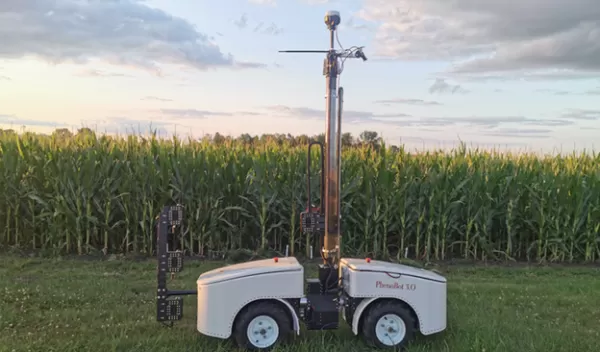
Wheeled robot measures leaf angles to help breed better corn plants
Researchers at North Carolina State University and Iowa State University have demonstrated an automated technology capable of accurately measuring the angle of leaves on corn plants in the field. The U.S. National Science Foundation-supported technology makes data collection on leaf angles significantly more efficient than conventional techniques, providing plant breeders with useful data more quickly.
"The angle of a plant's leaves, relative to its stem, is important because the leaf angle affects how efficient the plant is at performing photosynthesis," says Lirong Xiang, an engineer at NC State and first author of the paper published in the Journal of Field Robotics. "For example, in corn, you want leaves at the top that are relatively vertical but leaves farther down the stalk that are more horizontal. This allows the plant to harvest more sunlight. Researchers who focus on plant breeding monitor this sort of plant architecture because it informs their work.
"However, conventional methods for measuring leaf angles involve measuring leaves by hand with a protractor — which is both time-consuming and labor-intensive," Xiang says. "We wanted to find a way to automate this process — and we did." The new technology — called AngleNet — has two key components: the hardware and the software.
The hardware, in this case, is a robotic device that is mounted on wheels. The device is steered manually and is narrow enough to navigate between crop rows that are spaced 30 inches apart — the standard width used by farmers. The device itself consists of four tiers of cameras, each of which is set to a different height to capture a different level of leaves on the surrounding plants. Each tier includes two cameras, allowing it to capture a stereoscopic view of the leaves and enable 3D modeling of plants.
As the device is steered down a row of plants, it is programmed to capture multiple stereoscopic images, at multiple heights, of every plant that it passes.
All this visual data is fed into a software program that computes the leaf angle for the leaves of each plant at different heights.
"For plant breeders, it's important to know not only what the leaf angle is, but how far those leaves are above the ground," Xiang says. "This gives them the information they need to assess the leaf angle distribution for each row of plants. This, in turn, can help them identify genetic lines that have desirable traits — or undesirable traits."
To test the accuracy of AngleNet, the researchers compared leaf angle measurements done by the robot in a corn field to leaf angle measurements made by hand using conventional techniques.
"We found that the angles measured by AngleNet were within five degrees of the angles measured by hand, which is well within the accepted margin of error for purposes of plant breeding," Xiang says.
"We're already working with some crop scientists to make use of this technology, and we're optimistic that more researchers will be interested in adopting the technology to inform their work. Ultimately, our goal is to help expedite plant breeding research that will improve crop yield."
Adds Robert Fleischmann, a program director in NSF's Division of Biological Infrastructure, "NSF investments through its Major Research Instrumentation program lead to advances like this one in sensing and robotics technology that impact real-world outcomes in farming, plant breeding and crop production."


